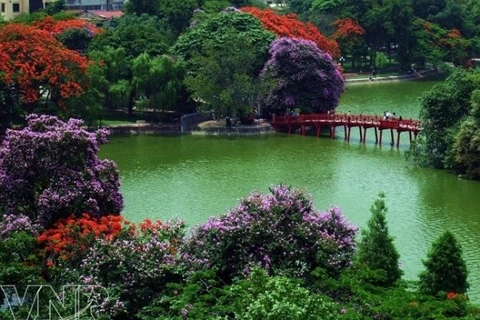 Chuon Ngo village in Phu Xuyen district is famous for sets of wooden furniture which are exquisitely inlaid with mother of pearl and worth up to billions of VND. (Photo: VNA)
Chuon Ngo village in Phu Xuyen district is famous for sets of wooden furniture which are exquisitely inlaid with mother of pearl and worth up to billions of VND. (Photo: VNA) Hanoi (VNA) – Hanoi is home to 1,350 craft villages, which is favourable condition for the capital city to develop tourism.
The most popular ones among both domestic and foreign tourists are Bat Trang pottery village in Gia Lam district, Van Phuc silk village in Ha Dong district, and Chuon Ngo mother-of-pearl inlay village in Phu Xuyen district.
Located in an area rich in clay, Bat Trang village enjoys advantages of ingredients to create fine ceramics.
Moreover, lying on a bank of the Red River between Thang Long and Pho Hien, two ancient trade centers in the north of Vietnam during 15th-17th century, Bat Trang’s ceramics were favourite products not only in domestic but also foreign markets thanks to Japan, Chinese and Western merchant boats.
In the 18th and 19th century, due to the foreign trade restricting policy of the administration of Trinh lords who ruled the north of the country, it was difficult for pottery products in Vietnam to be exported to foreign countries, and some famous pottery-making villages like Bat Trang and Chu Dau (Hai Duong province) experienced a hard time.
Since 1986, thanks to economic reforms and development, more attention has been vested in the village and the world gets a chance to know more about Vietnamese porcelain through the import of many high quality Bat Trang’s ceramic products.
Bat Trang ceramics are produced for daily household use such as bowls, cups, plates, pots, and bottles as well as for worshipping or decoration purposes.
Nowadays, artists bring into ceramics many innovations in production techniques, and creativity in products’ features, giving birth to many new products, and even daily household items may have the beauty like decoration ones.
Meanwhile, Van Phuc silk village is located about 10km west of downtown Hanoi on the Nhue River. It is known far and wide as the cradle of the finest silk in Vietnam.
Van Phuc silk products were particularly popular during the Nguyen Dynasty (1802-1945) which used them to dress the royal family and aristocrats.
Not only prominent in the domestic market, the traditionally hand-woven and hand-dyed silk has captured the loyalty of customers outside the country.
Between 1931 and 1932, Van Phuc silk was displayed at international exhibitions for the first time in Marseille and then Paris. At the Paris Fair in 1932, the Vietnamese silk was praised by the French as the most sophisticated product to come out of Indochina. From 1958 to 1988, the silk was mostly exported to East European markets.
Based on traditional designs, locals in Van Phuc silk village are creating more modern products to meet the increasing demands of domestic and foreign markets.
Touring Chuon Ngo village in the suburban district of Phu Xuyen, visitors will have an opportunity to admire picturesque images with high artistic values created from mother of pearl, demonstrating the high craftsmanship of artisans.
This place is famous for sets of wooden furniture which are exquisitely inlaid with mother of pearl and worth up to billions of VND.
Mother-of-pearl inlaid products of Chuon Ngo village are better than those of other places thanks to the sophisticated lines and vivid decorative details.
The village’s products are increasingly diverse and rich in designs, meeting domestic demand and even reaching out to international markets such as the UK, Russia, the US, the Netherlands, and Japan.
Furthermore, Chuon Ngo village still retains the traditional scenes of the northern region with millennia-old pagodas and houses.
To develop tourism in craft villages, Hanoi will select those recognised as traditional craft villages thanks to rich cultural identities, attractive surrounding, and favourable transport system to build them into sample models, then expanding to other villages.
The Hanoi craft village association has selected potential ones such as Thach Xa bamboo dragonfly-making village in Thach That district, Chuon Ngo village in Phu Xuyen district, Du Du wood sculpture village and Chuong conical hat making village in Thanh Oai district./.
VNA

























